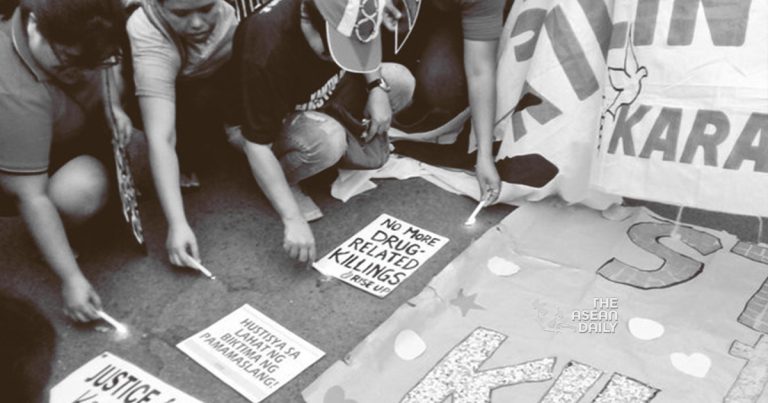23-3-2024 (MANILA) In the teeming metropolis of Metropolitan Manila, the capital region of the Philippines, a young woman named Tin (name changed) has been grappling with an unimaginable tragedy that has become all too familiar in the country’s relentless war on drugs. Hailing from a northern neighborhood of the sprawling city, Tin’s life was forever altered when her husband, Chrismel Serioso, fell victim to the very campaign that was supposed to safeguard communities.
It was a fateful day in October 2022, nearly a year after Rodrigo Duterte, the former president whose six-year term was marked by an infamous crackdown on illegal drugs, had stepped down. Tin’s world came crashing down as her 29-year-old husband was shot at, chased, and brutally beaten by a police officer on alleged charges of drug peddling.
Chilling footage captured the harrowing moment when Serioso lay motionless on the ground, his life ebbing away as the assailant casually walked away. It took nearly an hour for a police patrol to transport the victim to the hospital, where he was pronounced dead on arrival.
“The policeman’s alibi was that my husband was selling drugs, but authorities didn’t recover drugs from the scene,” Tin told DW, her voice laced with anguish and disbelief, adamantly denying her husband’s involvement in the illicit trade.
The police official responsible for the tragic incident, Patrolman Edwin Rivera Sibling, has since been dismissed from the force and now faces criminal charges. However, Tin’s story is a grim reminder that the scourge of drug-related violence continues to cast a dark shadow over the Philippines, despite assurances from the new administration of a change in approach.
President Ferdinand Marcos Jr., who assumed office in June 2022, has repeatedly stated that his government has made significant strides in curbing the illegal drug trade through prevention and rehabilitation efforts. During a recent visit to Germany, he even told Chancellor Olaf Scholz that the drug campaign has “completely changed” under his tenure.
However, the sobering reality on the ground tells a vastly different story. Data from the Dahas project, an initiative spearheaded by the University of the Philippines, paints a harrowing picture of the unabated drug-related violence that continues to grip the nation.
According to the project’s findings, the period from July 1, 2022, to June 30, 2023, witnessed a staggering 342 drug casualties, with an average of 0.9 deaths per day – a rate slightly higher than the 0.8 daily average recorded during Duterte’s final year in office. The grim toll shows no signs of abating, with 165 more deaths logged in the last six months of 2023 and 29 each in January and February of this year.
The yearlong anti-drug campaign spearheaded by Duterte left a trail of bloodshed in its wake, claiming thousands of lives as a result of both police operations and vigilante killings. While the government maintains that police officers killed approximately 6,200 suspected dealers who resisted arrest during these operations, human rights groups believe the true toll could be significantly higher.
The International Criminal Court (ICC) has launched a probe into the killings, prompting Duterte to withdraw the Philippines from the international tribunal in 2019. However, last year, the ICC rejected Manila’s appeal to halt the investigation, paving the way for the inquiry to continue – a development that has rekindled hope among those seeking justice for the extrajudicial killings.
Marcos, however, has remained defiant, declaring that his administration will not cooperate with the ICC probe, which he has described as “a threat to our sovereignty.”
Joel Ariate, the lead researcher of the Dahas project, shed light on a notable difference between the drug-related killings under Duterte and those under Marcos: the involvement of law enforcement agents.
During the Duterte administration, Ariate explained, approximately 70-75% of the killings occurred during buy-bust operations conducted by the Philippine National Police and the Philippine Drug Enforcement Agency. However, the number of deaths resulting from such drug stings has decreased under Marcos, accounting for about 45% of the total tally.
Alarmingly, Ariate noted a concerning rise in killings by unidentified groups, suggesting a shift in the dynamics of the violence.
“There’s no doubt that there has been less involvement of the state in the killings,” Ariate said. “But what’s alarming here is that the average number of killings in the Marcos administration has not been different, with 0.8 to 0.9 deaths per day, and we think this is not going down.”
Carlos Conde, a senior researcher at the Asia Division of Human Rights Watch (HRW), echoed these concerns, asserting that Duterte’s controversial anti-drug policies remain largely intact despite the government’s claims of a change in approach.
“The executive orders and issuances that operationalized the drug war are still in effect,” Conde said. “Mr. Marcos has not abolished those, so it should really make you wonder what he’s talking about when each time he says the drug policy of his administration is different.”
Conde further highlighted that the problems plaguing the drug offensive under Duterte, including the lack of due process and disregard for international human rights laws, have persisted under the new administration.
While the implementation of the drug campaign varies regionally, with certain areas like Davao City exhibiting a higher involvement of police or anti-narcotics agents in drug-related deaths, the overall trend is deeply concerning. Previously concentrated in the Manila region, the killings are now increasingly occurring in provinces such as Cebu and Negros Occidental, according to Ariate.
Conde emphasized that for Marcos to truly put an end to the cycle of violence, he must publicly declare an end to the war on drugs. He called for a holistic approach to combating illegal drugs, advocating for a public health perspective rather than treating it as a public safety issue.




